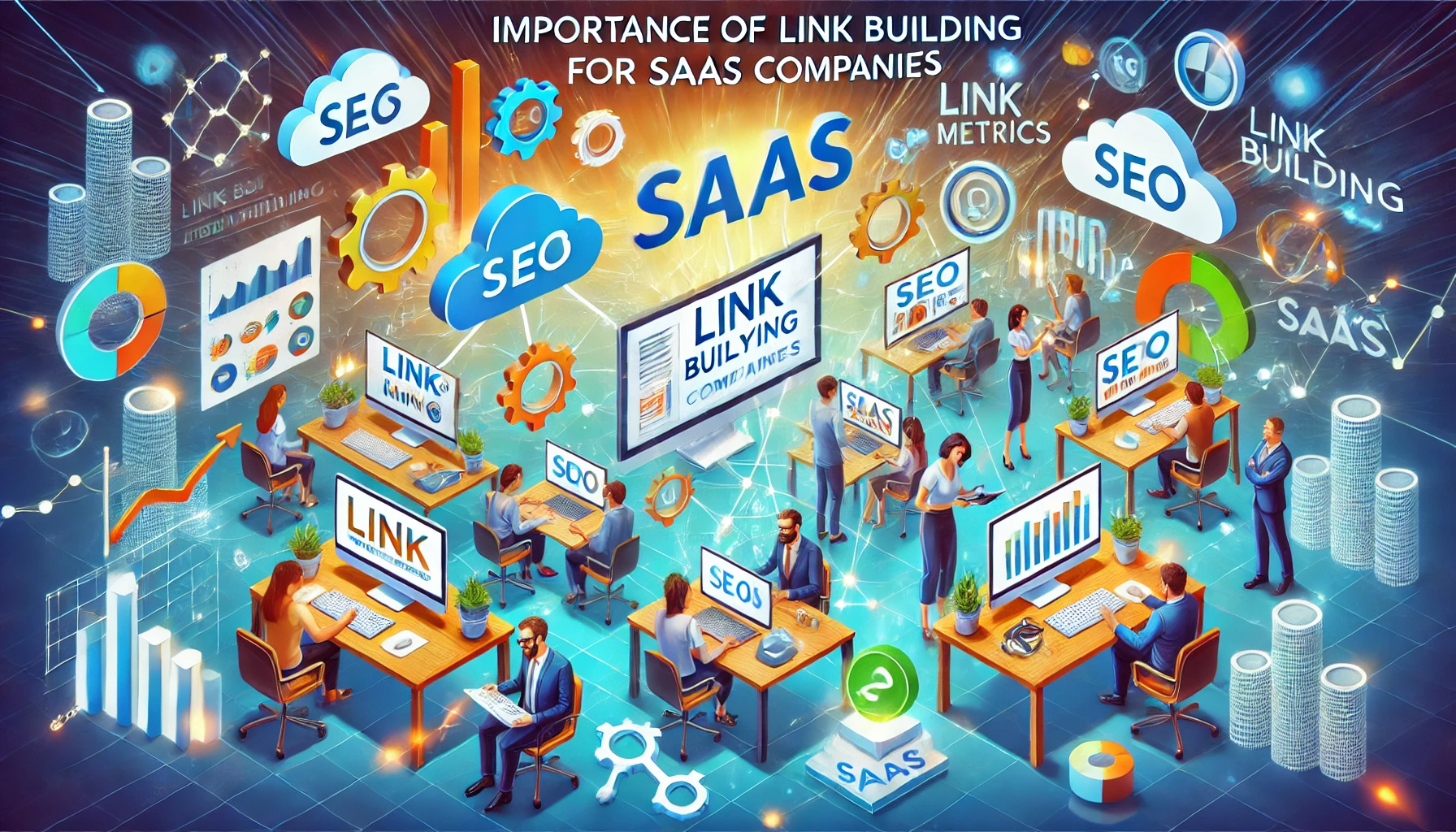The deliberate practice of obtaining links to your website from other websites is known as link building. These hyperlinks, commonly referred to as “backlinks,” are used by search engines to crawl the web, navigate between different websites, and determine the relevance and authority of a webpage. In essence, link building is an essential component of search engine optimization (SEO), aimed at increasing a website’s visibility and ranking in search engine results pages (SERPs).
Table of Contents
ToggleKey Aspects of Link Building:
- Relevance: How well your own website’s content relates to that of the connected site.
- Authority: The authority or trustworthiness of the site providing the backlink.
- Diversity: A variety of backlinks from different sources, such as blogs, news sites, and industry-specific websites.
- Anchor Text: The clickable text in a hyperlink, which should be relevant to the content it is linking to.
Benefits of Link Building:
- Improved Search Engine Rankings: Quality backlinks are a major factor in Google’s ranking algorithm, helping your site to rank higher for target keywords.
- Increased Referral Traffic: Backlinks can drive direct traffic from the referring domains to your site.
- Brand Authority and Visibility: Links from reputable sites can enhance your brand’s credibility and visibility within your industry.
- Faster Indexing: Links help search engines find new pages. High-quality backlinks can help search engines find and index your content more quickly.
Link Building Techniques:
- Content Creation and Promotion: Producing high-quality, valuable content that others want to link to and share.
- Guest Blogging: Writing articles for other websites in your industry, with backlinks to your site.
- Broken Link Building: Replacing broken links with your content by identifying them on other websites.
- Outreach: Contact webmasters, bloggers, and influencers to promote your content and request backlinks.
- Submissions to Directories: Adding your website to pertinent internet directories.
Importance of Link Building for SaaS Companies

1. Improved Search Engine Rankings
- SEO Authority: High-quality backlinks signal to search engines that your website is authoritative and trustworthy, which is crucial for SaaS companies aiming to rank for competitive keywords.
- Keyword Ranking: By acquiring backlinks from relevant and authoritative sources, SaaS companies can improve their rankings for targeted keywords, driving organic traffic.
2. Increased Organic Traffic
- Referral Traffic: Backlinks from high-traffic websites can lead to significant referral traffic, introducing your SaaS product to new potential customers.
- Sustained Growth: Consistent link-building efforts contribute to sustained organic traffic growth over time, providing a steady stream of potential leads.
3. Brand Authority and Trust
- Industry Credibility: Links from reputable websites in your industry enhance your brand’s credibility and authority, positioning your SaaS company as a leader in the field.
- Customer Trust: When potential customers see that other trusted websites link to your SaaS product, it builds trust and can influence their decision-making process.
4. Faster Indexing and Improved Visibility
- Search Engine Crawling: Backlinks help search engines discover and index new pages on your website more quickly, ensuring that your content gets visibility faster.
- Comprehensive Indexing: Regular link building can help ensure that all your valuable content is indexed, not just the main pages.
5. Competitive Advantage
- Staying Ahead: In the highly competitive SaaS industry, effective link-building can provide a significant edge over competitors who may not be as proactive in their SEO efforts.
- Market Positioning: Establishing a strong backlink profile helps position your SaaS company as a market leader, making it harder for new entrants to catch up.
Goals and Objectives of Link Building for SaaS Companies

1. Enhancing SEO Performance
- Boosting Search Rankings: Aim to improve rankings for key target keywords by acquiring high-quality backlinks from authoritative sources.
- Increasing Organic Traffic: Focus on generating a steady increase in organic traffic to the website through improved visibility in search engine results.
2. Building Brand Authority
- Establishing Industry Presence: Secure backlinks from reputable industry websites to enhance the company’s authority and credibility in the SaaS sector.
- Enhancing Brand Reputation: Use strategic link-building to associate the brand with trusted sources, thereby boosting overall brand reputation and trust.
3. Driving Qualified Leads
- Attracting Target Audience: Target backlinks from websites frequented by the ideal customer persona to drive relevant and qualified traffic.
- Increasing Conversions: Aim to convert the increased traffic from backlinks into leads and customers by linking to high-converting landing pages and resources.
4. Expanding Online Reach
- Diversifying Traffic Sources: Develop a diverse backlink profile to drive traffic from various sources, reducing dependency on a single traffic source.
- Global Reach: Target backlinks from international websites to expand the company’s reach beyond local markets and attract a global audience.
5. Supporting Content Marketing
- Promoting Content: Use link building to promote high-quality content, increasing its reach and engagement across different platforms.
- Enhancing Content Value: By acquiring backlinks to valuable content pieces, improve their perceived value and authority in the eyes of both users and search engines.
Identifying Target Audience for SaaS Companies
1. Market Segmentation
- Industry Analysis: Start by identifying the industries that would benefit most from your SaaS solution. Focus on sectors where your product solves specific pain points.
- Company Size: Determine whether your SaaS product is best suited for small businesses, mid-sized companies, or large enterprises. Tailor your link-building efforts to attract the right business size.
2. Customer Personas
- Defining Personas: Create detailed customer personas that include demographics, job roles, challenges, and goals. Understand the decision-makers and end-users of your SaaS product.
- Behavioural Insights: Analyze the behaviour and preferences of your target audience, such as their preferred content types, online platforms, and purchasing habits.
3. Needs and Pain Points
- Identifying Pain Points: Understand the specific problems and pain points your target audience faces. Ensure your content and link-building efforts address these issues directly.
- Solution Alignment: Position your SaaS product as the ideal solution to their challenges, highlighting features and benefits that resonate with their needs.
4. Competitive Analysis
- Analyzing Competitors: Study your competitors’ target audience to identify gaps and opportunities. Look at who they are targeting and how they are engaging with them.
- Differentiation: Use insights from competitor analysis to differentiate your product and tailor your link-building strategy to capture unmet needs within the target market.
5. Engagement Channels
- Preferred Platforms: Identify the online platforms and channels where your target audience is most active, such as industry forums, social media, and professional networks.
- Content Preferences: Understand the types of content that engage your target audience, whether it’s blog posts, videos, webinars, or infographics, and focus your link-building on these formats.
Competitor Analysis for SaaS Companies

1. Identifying Key Competitors
- Direct Competitors: Identify companies offering similar SaaS solutions targeting the same audience. Analyze their strengths and weaknesses.
- Indirect Competitors: Consider companies with different products but addressing similar customer needs, as they may offer alternative solutions that compete for your target audience’s attention.
2. Backlink Profile Analysis
- Tools and Techniques: Utilize tools like Ahrefs, SEMrush, or Moz to examine competitors’ backlink profiles. Identify the domains linking to them and the quality of these backlinks.
- Identifying Link Sources: Determine the types of websites linking to your competitors, such as industry blogs, news sites, and directories. This can highlight potential opportunities for your link-building efforts.
3. Content Strategy Assessment
- Content Types: Analyze the types of content your competitors are producing and promoting. Identify successful content formats such as blog posts, whitepapers, case studies, or webinars.
- Content Gaps: Look for gaps in competitors’ content strategies where you can provide more comprehensive or valuable content to attract backlinks.
4. Outreach and Engagement Tactics
- Outreach Methods: Study how competitors are conducting their outreach. This includes the type of emails they send, their social media engagement, and their participation in industry forums.
- Influencer Partnerships: Identify any influencers or industry leaders your competitors are collaborating with. These partnerships can reveal potential link-building opportunities for your brand.
5. Performance Metrics
- Key Metrics: Track metrics such as domain authority, number of referring domains, and traffic generated from backlinks. Compare these metrics with your own to gauge where you stand and identify areas for improvement.
- Benchmarking: Use competitor performance data to set realistic goals and benchmarks for your link-building strategy. Aim to match or surpass competitors’ achievements in key areas.
Keyword Research for SaaS Companies
1. Understanding Audience Intent
- Search Behavior: Analyze how potential customers search for solutions like yours. Identify common phrases and questions they use, which reflect their needs and pain points.
- User Intent: Differentiate between informational, navigational, and transactional queries to tailor your content and link-building strategies accordingly.
2. Identifying Relevant Keywords
- Core Keywords: Start with broad terms related to your SaaS product. Use these as a base to identify more specific, long-tail keywords that are highly relevant to your niche.
- Long-Tail Keywords: Focus on long-tail keywords that have lower competition and are more likely to convert, as they often indicate a higher purchase intent.
3. Competitive Keyword Analysis
- Analyzing Competitors: Use tools like Ahrefs, SEMrush, or Moz to discover which keywords your competitors are ranking for. Identify gaps and opportunities where you can outrank them.
- Keyword Gap Analysis: Perform a keyword gap analysis to find keywords that your competitors rank for but you do not. This can reveal valuable opportunities to target.
4. Using Keyword Research Tools
- Tool Selection: Leverage keyword research tools such as Google Keyword Planner, Ahrefs, SEMrush, and Moz. These tools offer information on keyword difficulty, competition, and search volume.
- Analyzing Data: Use these tools to gather data on potential keywords, including monthly search volume, competition level, and keyword trends over time.
5. Aligning Keywords with Content Strategy
- Content Planning: Integrate identified keywords into your content strategy. Plan blog posts, landing pages, and other content pieces around these keywords to improve SEO performance.
- On-Page Optimization: Ensure that your target keywords are used strategically in title tags, meta descriptions, headers, and throughout your content to maximize SEO benefits.
Creating High-Quality Content for SaaS Companies
1. Understanding Audience Needs
- Customer Pain Points: Determine the particular requirements and difficulties that your intended audience has. Create content that addresses these pain points, offering solutions through your SaaS product.
- Audience Segmentation: Tailor content to different segments of your audience, such as decision-makers, end-users, and influencers, ensuring relevance and value for each group.
2. Content Types
- Blog Posts: Write informative and engaging blog posts that provide value, insights, and practical advice related to your SaaS industry. Use SEO best practices to enhance visibility.
- Whitepapers and E-books: Develop in-depth, authoritative resources that showcase your expertise. These long-form contents can be used to capture leads and nurture potential customers.
- Case Studies: Highlight success stories and real-world applications of your SaaS product. Use data and testimonials to build credibility and demonstrate tangible benefits.
- Infographics and Visual Content: Create visually appealing content to simplify complex information and increase engagement. Infographics can generate backlinks and are very shareable.
3. Content Quality
- Research and Accuracy: Ensure all content is well-researched, accurate, and up-to-date. Use credible sources and data to support your points and enhance the reliability of your content.
- Originality and Uniqueness: Produce original content that offers unique insights or perspectives. Avoid duplicating content found elsewhere and strive to provide fresh, valuable information.
4. Engagement and Interactivity
- Interactive Elements: Incorporate interactive elements such as quizzes, surveys, and calculators to engage users and provide personalized experiences.
- Multimedia Integration: Use videos, podcasts, and webinars to diversify your content offerings. Multimedia content can reach different audience segments and increase engagement.
5. SEO Optimization
- Keyword Integration: Strategically integrate relevant keywords throughout your content, including in titles, headers, and body text, to improve search engine rankings.
- Readability and Formatting: Ensure content is easy to read and well-structured. Use headings, bullet points, and short paragraphs to enhance readability and user experience.
Guest Blogging for SaaS Companies
1. Identifying Opportunities
- Target Publications: Research and identify reputable blogs and publications within the SaaS industry that align with your target audience and niche.
- Audience Relevance: Choose platforms that attract your ideal customers, ensuring that your guest posts reach a relevant and interested audience.
2. Outreach Strategy
- Personalized Outreach: Craft personalized pitches that demonstrate your understanding of the host blog’s audience and content style. Highlight how your guest post will provide unique value.
- Building Relationships: Cultivate relationships with editors and bloggers by engaging with their content and contributing meaningful insights before pitching guest post ideas.
3. Creating Compelling Content
- Value-Driven Topics: Develop topics that address common pain points, offer solutions, or provide actionable insights relevant to the SaaS industry.
- Quality and Originality: Ensure your content is well-researched and original, and adds value to the host blog’s audience. Maintain high editorial standards and adhere to guest posting guidelines.
4. Optimizing for Link Building
- Strategic Link Placement: Include a relevant, contextual link back to your SaaS company’s website within the guest post content. Optimize anchor text to align with target keywords for SEO benefits.
- Author Bio and Credibility: Craft a compelling author bio that establishes your credibility and encourages readers to visit your website for more information or to learn about your SaaS product.
5. Promotion and Engagement
- Sharing and Promotion: Once published, actively promote your guest post through social media, email newsletters, and other channels to maximize its reach and engagement.
- Engaging with Readers: Monitor comments and respond promptly to reader feedback and questions on the guest post. Engaging with readers helps build relationships and establishes authority.
Developing Linkable Assets for SaaS Companies
1. Understanding Linkable Assets
- Definition: Linkable assets are valuable, high-quality content pieces or resources that attract backlinks naturally from other websites. They serve as foundational elements of an effective link-building strategy for SaaS companies.
2. Types of Linkable Assets
- Comprehensive Guides and E-books: Develop in-depth guides or e-books that provide valuable insights, tutorials, or industry benchmarks. These resources are often cited and linked to by other websites seeking authoritative content.
- Research Reports and Case Studies: Conduct original research or compile case studies that offer unique data, trends, or success stories within the SaaS industry. Data-driven content tends to attract links from both industry peers and media outlets.
- Interactive Tools and Calculators: Create interactive tools, calculators, or quizzes that provide practical value or solve specific problems for your target audience. Interactive content encourages engagement and sharing, driving natural link acquisition.
- Infographics and Visual Content: Design visually appealing infographics or videos that simplify complex information or present data in engaging visual content that is highly shareable and can attract links from blogs and social media platforms.
3. Strategic Promotion and Outreach
- Targeted Outreach: Proactively promote your linkable assets to relevant websites, influencers, and industry publications through personalized outreach. Highlight the unique value and benefits of linking to your content.
- Content Syndication: Syndicate your linkable assets across reputable platforms, directories, and industry newsletters to expand their reach and increase the likelihood of earning backlinks.
- Collaboration and Partnerships: Collaborate with industry influencers, guest bloggers, or complementary SaaS companies to co-create or promote your linkable assets. Partnerships can amplify your content’s visibility and link acquisition efforts.
4. Optimizing for Engagement and SEO
- User Experience: Ensure your linkable assets provide a seamless user experience across devices and platforms. Optimize loading speed, navigation, and accessibility to encourage prolonged engagement and sharing.
- SEO Best Practices: Incorporate relevant keywords, meta tags, and structured data markup into your linkable assets to enhance visibility in search engine results pages (SERPs). Strategic SEO optimization increases organic traffic and discovery.
5. Monitoring and Iteration
- Performance Tracking: Use analytics tools to monitor the performance of your linkable assets, including backlink acquisition, referral traffic, and engagement metrics. Determine the best-performing resources and those that need work.
- Continuous Improvement: Iterate and update your linkable assets regularly to ensure they remain relevant, accurate, and valuable to your audience. Updating content with new data or insights can reinvigorate link-building efforts over time.
Conclusion:
In conclusion, implementing a robust link-building strategy is indispensable for SaaS companies aiming to enhance their online visibility, attract targeted traffic, and establish authority within their industry. By focusing on creating high-quality content, engaging in strategic guest blogging, and developing linkable assets, SaaS companies can effectively earn valuable backlinks from authoritative sources. These efforts not only contribute to improved search engine rankings and organic traffic but also foster trust and credibility among target audiences. Moreover, continuous monitoring, optimization, and adaptation of link-building tactics ensure sustained growth and competitive advantage in the dynamic digital landscape of SaaS.





